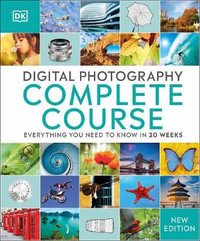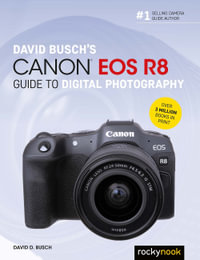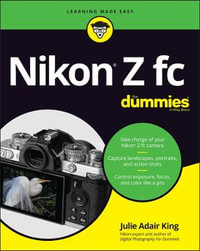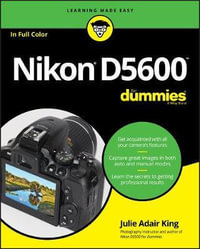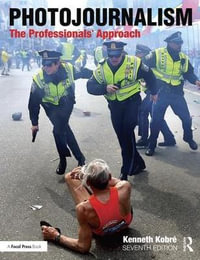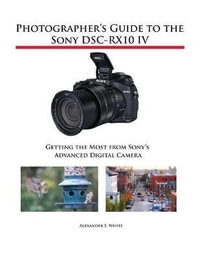Introduction to Underwater Photography 7
1.1 Essentials of a Good Underwater Photographer 8
1.2 The Effects of Light Underwater 8
1.3 Choosing a Compact Camera for Underwater Use 9
1.4 How Many Megapixels Do I Need? 10
1.5 Essential Accessories for Your Compact 13
1.6 Traveling With Your Compact Camera 15
1.7 Caring for Your Equipment Before and After a Dive 16
Understanding Your Camera’s Main Setting 19
2.1 Getting Started – Choosing The Correct Set-Up Options 20
2.2 Automatic Underwater Mode 21
2.3 Programme Mode 24
2.4 Understanding Aperture Settings 24
2.5 Understanding Shutter Speed Settings 25
2.6 Understanding Manual Mode 25
Exploring Your Camera’s Menu Settings 33
3.1 Autofocus –v- Manual Focus 34
3.2 Continuous Shooting 34
3.3 Custom Settings 34
3.4 Dynamic Range 34
3.5 Exposure Bracketing 35
3.6 Film Speed/ISO 35
3.7 Flash Exposure Compensation 35
3.8 Image Stabilisation Mode 38
3.9 Infinity Mode 38
3.10 Metering Modes 38
3.11 Noise 41
3.12 Optical Zoom –v- Digital Zoom 41
3.13 RAW –v- JPEG 42
3.14 Rear Curtain Synchronisation or Slow Sync Speed 42
3.15 Shooting with Colour Options 45
3.16 Understanding the Exposure Compensation Tool (EV+/EV-) 45
3.17 Using the Built-In Flash With Your Camera 50
3.18 Using the LCD Screen –v- the Viewfinder 52
3.19 Using the Video Mode Underwater 52
3.20 Using Your Camera’s White Balance Settings Underwater 53
Choosing Different Accessories for Your Compact 59
4.1 Choosing a Lens 60
4.2 Using a Close-Up Lens 60
4.3 Wide-Angle Lenses 63
4.4 Using a Fisheye Lens 64
4.5 Filters for Fabulous Underwater Colours 67
4.6 Using a Focus or Modeling Light 68
Lighting Your Subject Underwater 73
5.1 Introduction to Underwater Lighting 74
5.2 Considerations When Buying a Strobe 75
5.3 Arms and Trays for Your Strobe 76
5.4 Tricks and Tips Before Using Your Strobe 78
5.5 What Is Backscatter? 79
5.6 One Strobe or Two 80
5.7 Using a Strobe to Capture Macro Subjects 81
5.8 Strobes for Wide-Angle Scenes 84
Natural Light Photography – Ideal for Snorkelling 87
6.1 Natural Light Photography – Ideal for Snkorkelling 88
Underwater Photography in Temperate Waters 93
7.1 Underwater Photography in Temperate Waters 94
Composing a Great Underwater Photograph 99
8.1 Abstracts 100
8.2 Camouflage 102
8.3 Caves 106
8.4 Close-Focus Wide-Angle Photographs 109
8.5 Contrasting Colours Underwater 110
8.6 Photographing Divers 112
8.7 Eye-to-Eye Contact 114
8.8 Fast Moving Subjects 115
8.9 Fish Behaviour and Interaction 115
8.10 Fish Portrait 118
8.11 Landscape or Portrait Shots 119
8.12 Leading/Diagonal Lines 120
8.13 Which Way Should Your Subject Go? 122
8.14 Looking Up or Down on a Subject? 123
8.15 Photographing Macro Subjects 125
8.16 Night Dives 127
8.17 Reflections 128
8.18 Rule of Thirds 129
8.19 Same Photo, Different Idea 132
8.20 Schooling Fish 135
8.21 Shapes 137
8.22 Sharks 138
8.23 Silhouettes 139
8.24 Split-Level Shots 139
8.25 Wide-Angle Reef Scenes 140
8.26 Photographing Wreck Scenes 142
Downloading and Shoring Your Images 147
9.1 Downloading and Storing Your Images 148
Practise, Practise, Practise 151
10.1 Practice, Practise, Practise 152
Guest Gallery 153
11.1 Guest Gallery 154
Notes 165
Glossary 172
Index 174


